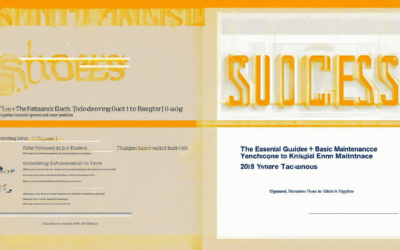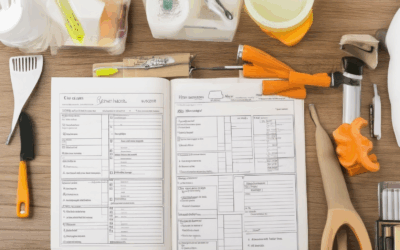Discover the incredible versatility of DIY repair ideas that can transform your home maintenance routine. Whether you’re tackling leaky faucets, repairing broken appliances, or exploring creative DIY crafts, this guide offers a comprehensive approach to handling home repairs with ease. From fixing minor damages to undertaking more complex projects, DIY solutions are not only cost-effective but also empower you to take control of your home environment. Learn how to prioritize essential repairs, budget for emergencies, and extend the lifespan of your belongings with practical tips and insights. This article dives into the most common DIY repairs, easy fixes for everyday problems, and innovative crafts to elevate your home decor. Get ready to embrace the world of DIY repairs and unlock a new level of confidence in maintaining your living space.

Most Common DIY Home Repairs
Fixing squeaky doors and windows, patching drywall, unclogging toilets, and painting interior walls are among the most common DIY home repairs that homeowners often undertake. However, there are several other essential tasks that are frequently tackled by DIY enthusiasts. Below is a list of the most common DIY home repairs, along with practical tips and insights:
- Fixing Leaky Pipes : Identifying and addressing leaks in plumbing systems is a frequent DIY task. Locate the source of the leak, turn off the water supply, and replace worn-out washers or pipes as needed.
- Replacing Light Switches : Upgrading or replacing outdated light switches is a common repair. Simply turn off the power, remove the old switch, and install a new one according to the manufacturer’s instructions.
- Installing Ceiling Fans : Adding ceiling fans to a room can improve airflow and comfort. Measure the area, attach the fan to the ceiling, and secure it properly using the mounting hardware provided.
- Repairing Furniture : Small damages like scratches or loose handles can often be fixed with basic tools. Sand the affected area, apply a matching finish, and tighten any loose components.
These repairs not only save money but also empower homeowners to maintain their properties effectively. Whether it’s a minor fix or a more substantial project, DIY repairs can enhance both functionality and aesthetics. Always prioritize safety and consult reliable resources or professionals when unsure about complex tasks.
What is the Easiest Thing to Fix?
The easiest thing to fix often depends on the situation, but here are some common quick fixes that can save time and effort:
- Small Leaks:** Duct tape or super glue can temporarily fix small cracks or holes in pipes, furniture, or appliances.
- Wobbly Chairs:** Tighten loose chair legs by adjusting the tension or using a screwdriver to secure them.
- Clogged Drains:** Use a plunger to clear minor blockages in sinks, tubs, or toilets before calling a professional.
- Burnt Out Bulbs:** Replace blown light bulbs by checking the bulb’s power level and ensuring the socket is functioning properly.
- Scratched Screens:** Apply a screen repair kit or clear nail polish to fix small scratches on phone or computer screens.
- Fading Clothes:** Sort laundry by color and fabric type to ensure proper washing temperatures and detergent usage.
- Loose Tiles:** Gently tap on suspecting tiles to check for looseness; if needed, apply adhesive or replace with a new tile.
- Dripping Faucets:** Adjust the faucet handle to stop water flow or replace the washer if necessary.
- Uneven Floors:** Sand uneven spots or use shims to level floors before applying finish.
- Broken Items:** Replace broken items like dishes or electronics with affordable alternatives or seek professional repair services.
For more DIY tips and maintenance guidance, explore our DIY Guides section for step-by-step solutions tailored for homeowners.

How to Pay for Unexpected Home Repairs
When faced with an unexpected home repair, it’s crucial to act quickly while exploring all possible funding options. Here’s a structured approach to managing the financial aspect:
- Utilize Emergency Funds: A dedicated emergency fund is ideal for covering unexpected expenses. Consider setting aside a portion of your monthly income specifically for such scenarios.
- Personal Loan: If you have good credit history, applying for a personal loan can provide immediate cash flow. Compare rates and terms to find the most suitable option.
- Home Equity Loan or HELOC: Tap into your home’s equity for larger repair costs. These loans often offer competitive rates but require careful consideration of repayment terms.
- Service Plans and Warranties: Explore service agreements for appliances and systems to spread repair costs predictably over time, offering peace of mind and budget stability.
- Crowdfunding and Trade Discounts: For smaller projects, consider crowdfunding platforms or reaching out to trade networks for potential discounts or contributions from trusted contacts.
- Local Assistance Programs: Investigate government or NGO initiatives that may offer financial aid or rebates specifically for home repairs.

What Items Are Easy to Repair?
Many household and electronic items are relatively simple to repair with the right tools and knowledge. Here’s a list of common items that are easy to fix:
- Appliances:
- Microwave ovens – Common issues like broken door seals or faulty touchscreens can often be resolved with replacement parts.
- Refrigerators – Issues such as ice maker problems or door adjustments can usually be fixed with basic troubleshooting and replacement components.
- Oven/range – Simple repairs like broken glass panels or gas valve issues can often be addressed with standard tools.
- Small Electronics:
- Smartphones – Cracked screens or malfunctioning buttons can sometimes be repaired with replacement parts or DIY kits.
- Tablets – Similar to smartphones, many issues like broken displays or battery problems can be fixed with replacement components.
- Furniture:
- Chairs – Loose screws or wobbly legs can often be fixed with a few simple tools.
- Tables – Table legs that are uneven or wobbly can be adjusted or replaced if needed.
- Plumbing Fixtures:
- Bathrooms – Leaky faucets or slow drains can usually be fixed with basic plumbing tools and replacement parts.
- Toilets – Common issues like clogged traps or weak flushes can often be resolved with simple cleaning or part replacements.
- HVAC Systems:
- Air conditioning units – Replacing air filters and fixing minor issues like blocked vents can often restore functionality.
- Heating systems – Basic repairs like replacing thermostats or clearing ducts can be done by DIYers with some experience.
- Kitchen Appliances:
- Dishwashers – Malfunctioning wash cycles or leaky hoses can often be fixed with diagnostic checks and part replacements.
- Ranges – Issues like gas leaks or broken ignitors can sometimes be resolved with professional-grade tools.
- Garden Equipment:
- Lawn mowers – Repairs like blade sharpening or engine tune-ups can be done with basic tools.
- Garden trimmers – Broken strings or clogged debris can often be fixed with simple maintenance procedures.
- Tools:
- Hammers – Dented handles or loose heads can be realigned or replaced with basic tools.
- Screwdrivers – Stripped screw bits can be easily replaced with new bits or handles.
- Cars:
- Tires – Punctures or worn-out treads can be quickly fixed with tire patches or replacements.
- Windshield – Chips or cracks can often be repaired with specialized adhesives.
Most Common Repairs
The most common repairs in a home can vary greatly depending on the age and condition of the property. Here’s a breakdown of the typical issues homeowners face:
- HVAC Systems
- Furnace malfunction
- Air conditioning unit issues
- Refrigerator problems
- Water heater failures
- Plumbing Issues
- Bathrooms leaks
- Kitchen clogged pipes
- Water pressure problems
- Septic tank backups
- Electrical Problems
- Flickering lights
- Switches not working
- Outlets not functioning
- Electrical wiring malfunctions
- Damage to Property
- Roof leaks
- Windows broken or damaged
- Doors not closing properly
- Walls with cracks or holes
- Water Damage
- Basement flooding
- CEiling stains
- Mold growth
- Standing water in yards
Tips for Preventive Maintenance
Scheduling regular inspections and maintenance can save you from costly repairs down the line. Consider these proactive steps:
- Clean gutters and drains regularly
- Inspect appliances monthly
- Test smoke detectors and alarms
- Check for signs of wear on major systems
Need professional assistance? Schedule service today with our trusted team of experts!
For more detailed guides and expert advice, explore our maintenance blog . We cover everything from DIY projects to advanced fixes, ensuring you’re well-prepared for whatever comes your way.

What Should I Repair First in an Old House?
When faced with an old house that needs repairs, it’s crucial to approach the situation methodically to ensure safety and effectiveness. Here’s a prioritized list of essential repairs based on urgency and impact:
- Roof Inspection and Repairs
- Why: A damaged roof can lead to structural issues and water damage.
- What to Check: Look for missing shingles, sagging sections, or visible leaks.
- Action: Contact a roofing contractor for an assessment and necessary repairs.
- Foundation Evaluation
- Why: A compromised foundation can result in costly structural damage.
- What to Check: Inspect for cracks, uneven surfaces, or gaps between the house and the ground.
- Action: Engage a professional to evaluate and stabilize the foundation if needed.
- Window and Door Weather Stripping
- Why: Drafts can lead to energy loss and moisture issues.
- What to Check: Examine weather stripping for wear and tear.
- Action: Replace outdated or damaged strips to enhance energy efficiency.
- Interior Wall and Ceiling Inspection
- Why: Peeling paint can indicate underlying issues like moisture.
- What to Check: Look for peeling paint and signs of mold or mildew.
- Action: Address any moisture problems and repaint as needed.
- Electrical System Check
- Why: Outdated wiring poses a fire risk.
- What to Check: Inspect circuit breakers and outlets for functionality.
- Action: Hire an electrician to update or repair the system if necessary.
- Plumbing System Inspection
- Why: Corroded pipes can lead to leaks and water damage.
- What to Check: Look for visible corrosion or leaks under sinks.
- Action: Have a plumber evaluate and replace any deteriorating pipes.
- Chimney and Ventilation Systems
- Why: Blockages can lead to dangerous fumes entering the house.
- What to Check: Inspect for soot buildup or blockages.
- Action: Clean and service the chimney and vents to ensure proper airflow.
- Heating, Ventilation, and Air Conditioning (HVAC) System
- Why: Efficient operation is vital for comfort and energy savings.
- What to Check: Ensure the system is functioning correctly and consider an annual service visit.
- Action: Schedule a professional to inspect and service the system if needed.
- Flooring and Attic Inspection
- Why: Uneven floors can indicate structural issues, while pests in the attic pose health risks.
- What to Check: Look for sags or uneven spots in flooring and inspect the attic for pests or insulation problems.
- Action: Address structural issues and treat for pests if necessary.
By addressing these areas in order, you can ensure that your old house remains safe, functional, and comfortable. Prioritizing these repairs not only prevents minor issues from becoming major problems but also enhances the overall value and livability of your home.




0 Comments